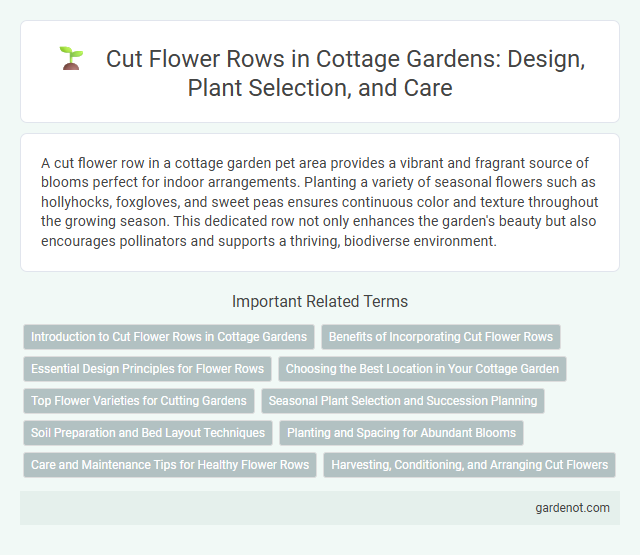A cut flower row in a cottage garden pet area provides a vibrant and fragrant source of blooms perfect for indoor arrangements. Planting a variety of seasonal flowers such as hollyhocks, foxgloves, and sweet peas ensures continuous color and texture throughout the growing season. This dedicated row not only enhances the garden's beauty but also encourages pollinators and supports a thriving, biodiverse environment.
Introduction to Cut Flower Rows in Cottage Gardens
Cut flower rows in cottage gardens provide an organized space where a variety of blooms like dahlias, zinnias, and cosmos thrive for fresh cutting. These rows enhance floral diversity while offering easy access for harvesting vibrant flowers, promoting sustainable garden maintenance. Positioning cut flower rows strategically near pathways maximizes sunlight exposure and facilitates routine care essential for robust growth and continuous blooms.
Benefits of Incorporating Cut Flower Rows
Cut flower rows enhance a cottage garden by providing a continuous supply of fresh, vibrant blooms for indoor arrangements, enriching the garden's aesthetic appeal and seasonal variety. These rows promote biodiversity by attracting pollinators such as bees and butterflies, which improve overall plant health and productivity. Integrating cut flower rows also supports sustainable gardening practices by reducing the need for store-bought flowers, lowering environmental impact.
Essential Design Principles for Flower Rows
Essential design principles for a cut flower row in a cottage garden emphasize plant height variation, color harmony, and seasonal succession to ensure continuous blooms. Incorporating tall plants like delphiniums at the back, mid-height dahlias in the middle, and low-growing flowers such as cosmos in the front creates visual depth and easy harvesting. Using a mix of perennials and annuals tailored to the local climate enhances bloom duration and supports pollinator diversity.
Choosing the Best Location in Your Cottage Garden
Selecting the ideal spot for your cut flower row in a cottage garden involves assessing sunlight exposure, soil drainage, and proximity to water sources. Choose a location that receives at least six hours of direct sunlight daily to ensure vibrant blooms and robust growth. Well-drained soil rich in organic matter supports healthy root development and prolonged flowering, enhancing the overall beauty of your cottage garden.
Top Flower Varieties for Cutting Gardens
Top flower varieties for cutting gardens in a cottage garden setting include classic blooms like dahlias, zinnias, and cosmos, prized for their long stems and vibrant colors. Peonies and sunflowers also provide sturdy stalks and lush petals, making them ideal choices for fresh floral arrangements. Choosing a diverse mix of these hardy, high-yielding flowers ensures continuous blooms and abundant cut flowers throughout the growing season.
Seasonal Plant Selection and Succession Planning
Cut flower rows in a cottage garden thrive with seasonal plant selection, prioritizing varieties like tulips and daffodils for spring, zinnias and cosmos in summer, and dahlias or chrysanthemums in fall to ensure continuous blooms. Succession planting involves staggering sowing dates and choosing overlapping bloom periods to maintain a steady harvest of fresh flowers throughout the growing season. Incorporating perennial cut flowers such as peonies and delphiniums enhances the garden's year-to-year productivity and floral diversity.
Soil Preparation and Bed Layout Techniques
Preparing soil for a cut flower row in a cottage garden requires loosening the soil to a depth of at least 12 inches and incorporating organic matter such as compost or well-rotted manure to enhance fertility and drainage. Raised bed layouts with defined rows spaced 12 to 18 inches apart promote air circulation and ease of access for harvesting and maintenance. Proper soil pH, ideally between 6.0 and 7.0, supports optimal nutrient uptake crucial for vigorous flower growth and prolonged bloom periods.
Planting and Spacing for Abundant Blooms
Plant cut flower rows with a spacing of 12 to 18 inches between plants to promote strong air circulation and reduce disease risk, ensuring healthier growth and abundant blooms. Select sun-loving varieties such as zinnias, cosmos, and sunflowers, which thrive in well-drained soil enriched with organic matter for optimal flower production. Regularly deadhead spent blossoms to encourage continuous flowering and maintain a vibrant, productive cottage garden display.
Care and Maintenance Tips for Healthy Flower Rows
Regular watering and mulching are essential for maintaining healthy cut flower rows, ensuring consistent soil moisture and weed control. Pruning spent blooms promotes continuous flowering while preventing disease by removing decayed plant material. Applying balanced organic fertilizers every 4-6 weeks supports vigorous growth and vibrant blooms in cottage garden cut flower rows.
Harvesting, Conditioning, and Arranging Cut Flowers
Harvesting cut flowers in a cottage garden involves selecting blooms at their peak stage, typically early morning when stems are firm and moisture levels are high. Proper conditioning requires removing lower leaves, cutting stems at an angle under water, and placing flowers in clean water with floral preservative to extend vase life. Arranging cut flowers emphasizes layering various bloom shapes and colors to create a natural, abundant appearance, often incorporating foliage for texture and balance.
Cut flower row Infographic

 gardenot.com
gardenot.com